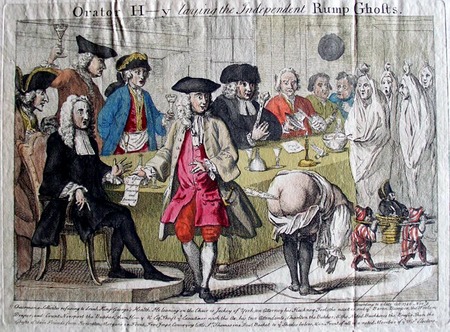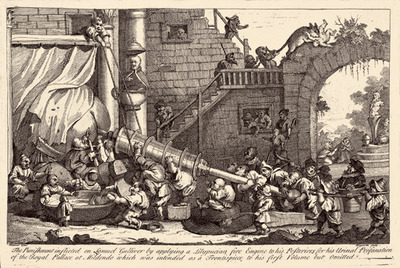In December 1726, William Hogarth (1697-1764) designed an etching, entitled The Punishment Inflicted on Lemuel Gulliver, in response to Jonathan Swift’s Gulliver’s Travels [below]. An enormous backside (Britain) is being given an enema by the Lilliputians (the Whig ministry and church). The Prime Minister, Sir Robert Walpole, supervises the action.
On July 30, 1746, a lawyer named David Thomas Morgan (1695-1746) was executed for his part in the second 1745 Jacobite Rebellion. Within days, an anonymous print, using Hogarth’s premise, was issued “for Jonathan’s father.” It is titled Orator H—y laying the Independent Rump Ghosts. A faithful narrative of the wonderful and surprising appearance of Counsellor Morgan’s ghost: at the meeting of the independent inhabitants of the city and liberty of Westminster, last Friday night being the first of August; Giving a full and true Account of the Behaviour of the Club upon that fearful Occasion; together with a genuine copy of the speech he made to them, without his head.
The title refers to Reverend John Henley (1692-1756) who performed monologues or lectures at a theater near Lincoln’s Inn Fields and was briefly arrested in 1746 for outspokenness supporting the Battle of Culloden (the last battle of the Jacobite uprising, won by the English in 40 minutes, leaving over 1,200 dead).
Henley is shown drinking and smoking with a political club whose chairman is at the head of the table, followed by Jakey of York, Baron Bumpe, Count Newport the Butcher, Henley, Esq’ Thrift ye Executioner, Charlton the Butcher, and Buckhorse the Bruiser. They are interrupted by several shrouded figures, described as the The Independent Rump Ghosts, led by Counsellor Morgan, who moons the club and then, farts “See What you shall all come to.”

